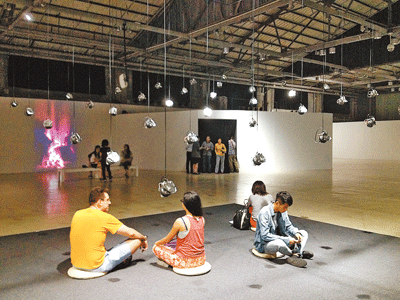Cao Zhen caozhen0806@126.com SINCE August, OCT Art Terminal (OCAT) has been running its first ever dedicated sound art exhibit, dubbed “Archival Listening,” in Exhibition Hall B. It’s part of the “Schizophonia Exhibition Series,” which just added a few sound installations Nov. 14 at Exhibition Hall A. Schizophonia is a term coined by Canadian scholar Murray Schafer in 1971. Borrowing from “schizophrenia,” the word describes the separation between sounds from their original context, a result of the electric revolution after the invention of devices such as the telephone, the radio and the phonograph. Schafer was actually using the term to criticize sonic aberration and pollution in modern society. Yet the fact is that schizophonia is a crucial part of modernity. Curated by Taiwanese sound artist Dajuin Yao, the Schizophonia exhibition series looks at a variety of issues brought up by works that consciously foreground the schizophonic nature of sound art, and, at the same time, attempt to understand how sound can be a covert coding system through which we can understand the world. Even viewers with no previous knowledge about sound art as a contemporary art form can enjoy the interactive exhibits. While most sound installations are placed in separate dark rooms or require headphones to listen, U.S. sound artist Paul DeMarinis’ “Jiffy_Pop” installation stuns viewers with a popcorn-like sound in spacious Hall A.  The piece consists of 36 small loudspeakers covered with tinfoil hanging from the ceiling. Each one is powered by a voltage that is interrupted by the mechanism of a needle suspended over the tinfoil. This produces a pop in each one of the speakers that propel the needles back and forth in a somewhat chaotic rhythmic beating, each one being a “different drummer,” so to speak. Meanwhile, the play of light on the tinfoil diaphragm offers a potential for lighting either directly or by reflection onto the gallery walls. Another eye-catching exhibit is the three-screen video projection “Mutists” created by the five-person Hangzhou Sound Unit. Performers in the video mime sounds with their mouth and viewers can hear the sounds through headphones at the exhibition. The artists intend to create a mutual massaging between the sounds and the faces and create poignancy for the short silences. In various dark rooms at the exhibition, visitors can hear immersive sounds from chaotic TV entertainment shows, Beijing streets or rainforests around the world. Weng Wei’s “Entertainment Pesticide II” criticizes the noise phenomenon in Chinese TV entertainment culture. Through forced multi-channel listening to simultaneous playback of these TV clips, and being transported into the different spatial-temporal context of the art space, these noises, or pollutants as the artist describes them, are distilled. Spanish sound artist Francisco Lopez’s “Hyper-Rainforest” was recorded between 1990 and 2010 at multiple locations of tropical, subtropical and cold rainforests in South America, Australia, China, Africa, New Zealand, Japan and the United States. For over 25 years he has worked extensively doing field recordings of sound environments in rainforests all over the world. However, he does not aim at a representation or a simulation of the natural reality of the original locations. Instead, his challenge with this piece has been the development of an elaborate form of sonic hyper-reality that gives rise to a self-sufficient virtual world of sound created exclusively with a multitude of these original materials. The Archival Listening Exhibition in Hall B displays posters of past sound art festivals in various Chinese cities and a wide variety of sound art works can be accessed via seven listening stations. Each station chair offers a completely different playlist. Rare physical objects such as CDs, documents and videos are also on display. A custom-designed “Timeline of Chinese Sound Art” section at the exhibition allows viewers to experience the development of sound art in China through English-language captions and interactive listening. Dates: Until Dec. 13 Hours: 10 a.m.-5:30 p.m. Closed Mondays Venue: OCT Art Terminal, South Area, OCT-LOFT, Nanshan District (南山区华侨城创意文化园南区OCT当代艺术中心) Metro: Luobao Line, Qiaocheng East Station (侨城东站), Exit A | 
